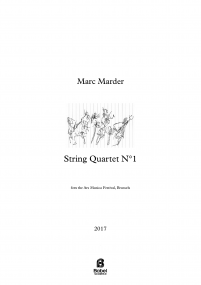Costas oscuras de honda presencia
Resonancias de un poema de Juan Ramón.
7,30 €
Digital version (+0,00 €) instant download
Printed format (+14,80 € printing and shipping). Colissimo7-14 days aprox.
When you buy a score, you can contact the composer right here!
Specifications
Region
Europe
Estimated Duration
1 - 5min
Date
2000
ISMN : 979-0-2325-7488-2
Videos on this piece
Notes on this piece EN: “Costas oscuras de honda presencia” reflects the impression left on me by the poem “Navegante”, from the late Juan Ramón Jiménez (Nobel Prize in Literature, 1956), a poem of cold and serene beauty, distant, “spiritual”. despite not being religiously themed. The work tries to transmit that “stillness”, which is translated into sound through harmonic, static music, based on a series of maintained chords of great density, and within which all the instruments move, creating an intense musical life, with superpositions, often polyrhythmic, of cells formed on chord notes, and polarizations of certain sounds within the chord, which “attract attention” using resources such as the repetition of timbrally varied notes, the repetition of notes grouped in different coincidences verticals or also its “detuning”, taking advantage of the possibility of using quarter tones on the part of the string. At the same time, these chords are handled “externally”, contracting or dilating their duration to the extent that tension or relaxation is expressed in the formal development. Towards the middle of the piece we find a high climax, where a section begins that is more liberated from the initial harmonic approach, in which the string takes center stage, and in which dynamics have a special importance. Next, the piano intervenes with a small solo. The piece ends with a quick recapitulation that reproduces the static spirit of the first bars of the work.
ES: “Costas oscuras de honda presencia” refleja la impresión que dejó en mi el poema “Navegante”, de la última época Juan Ramón Jiménez, un poema de una fría y serena belleza, lejano, “espiritual” pese a no ser de temática religiosa. La obra intenta transmitir esa “quietud”, que se traduce en sonido mediante una música armónica, estática, basada en una serie de acordes de una gran densidad mantenidos, y en cuyo interior se van moviendo todos los instrumentos, creando una intensa vida musical, con superposiciones, con frecuencia polirrítmicas, de células formadas sobre notas de los acordes, y polarizaciones de determinados sonidos del interior del acorde, que “atraen la atención” utilizando recursos como la repetición de notas variadas tímbricamente, la repetición de notas agrupadas en diferentes coincidencias verticales o también su “desafinación”, aprovechando la posibilidad de usar cuartos de tono por parte de la cuerda. A la vez, estos acordes son manejados “exteriormente”, contrayendo o dilatando su duración en la medida en que se quiere expresar tensión o distensión en el desarrollo formal. Hacia la mitad de la pieza nos encontramos con un clímax de altura, donde comienza una sección más liberada del planteamiento armónico inicial, en la que la cuerda toma el protagonismo, y en la que la dinámica tiene una especial importancia. A continuación, el piano interviene con un pequeño solo. La pieza finaliza con una rápida recapitulación que reproduce el espíritu estático de los primeros compases de la obra.
Add to a playlist
- Login to create your own lists
ES: “Costas oscuras de honda presencia” refleja la impresión que dejó en mi el poema “Navegante”, de la última época Juan Ramón Jiménez, un poema de una fría y serena belleza, lejano, “espiritual” pese a no ser de temática religiosa. La obra intenta transmitir esa “quietud”, que se traduce en sonido mediante una música armónica, estática, basada en una serie de acordes de una gran densidad mantenidos, y en cuyo interior se van moviendo todos los instrumentos, creando una intensa vida musical, con superposiciones, con frecuencia polirrítmicas, de células formadas sobre notas de los acordes, y polarizaciones de determinados sonidos del interior del acorde, que “atraen la atención” utilizando recursos como la repetición de notas variadas tímbricamente, la repetición de notas agrupadas en diferentes coincidencias verticales o también su “desafinación”, aprovechando la posibilidad de usar cuartos de tono por parte de la cuerda. A la vez, estos acordes son manejados “exteriormente”, contrayendo o dilatando su duración en la medida en que se quiere expresar tensión o distensión en el desarrollo formal. Hacia la mitad de la pieza nos encontramos con un clímax de altura, donde comienza una sección más liberada del planteamiento armónico inicial, en la que la cuerda toma el protagonismo, y en la que la dinámica tiene una especial importancia. A continuación, el piano interviene con un pequeño solo. La pieza finaliza con una rápida recapitulación que reproduce el espíritu estático de los primeros compases de la obra.
Instrumentation
Piano
Violin
Cello
Violin
Cello
Recording
Live Recording in San Francisco Church from Villafranca del Bierzo (León).
Score Details
Format - A4 / US Letter
Pages - 24
Pages - 24












